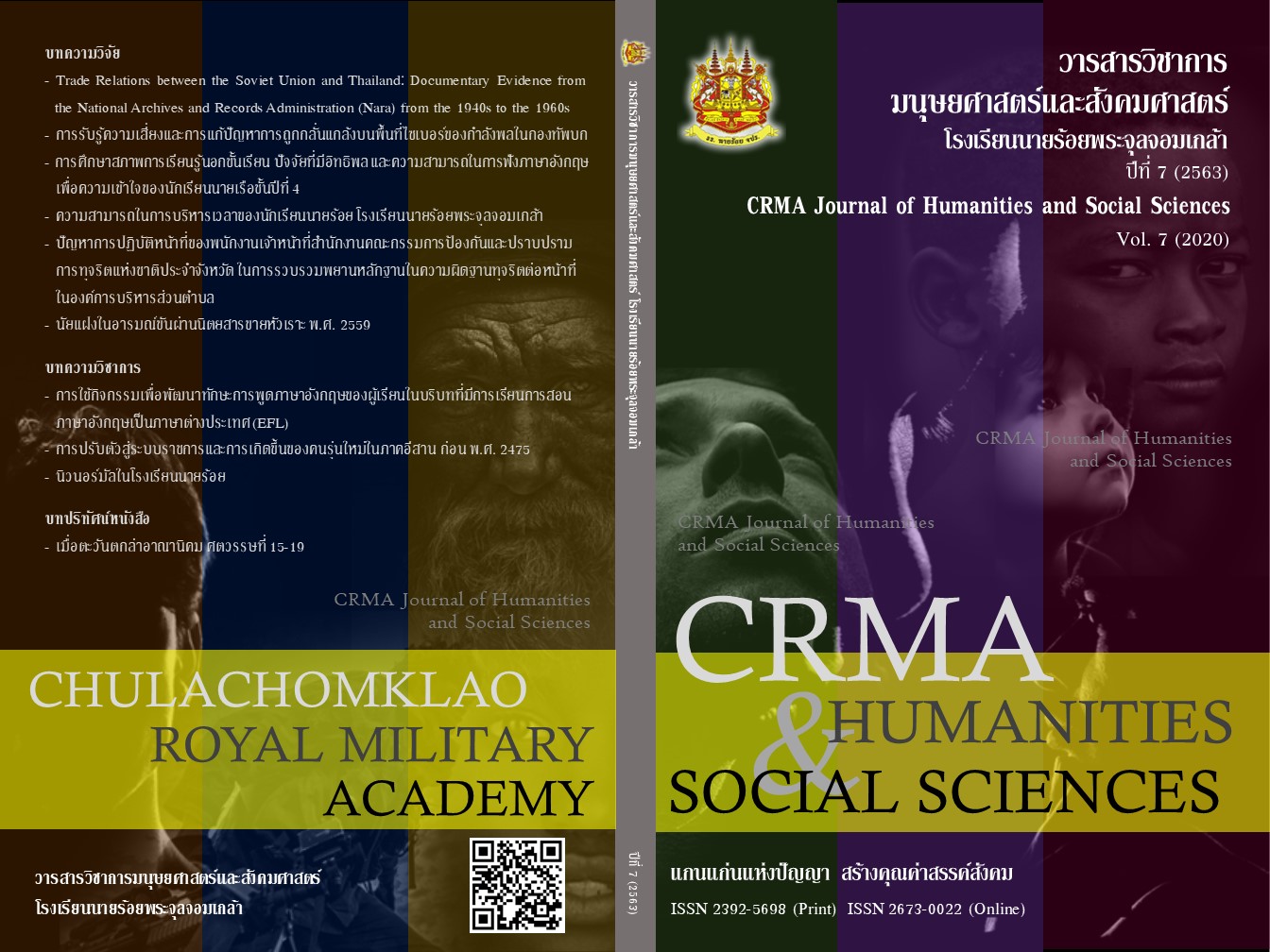นัยแฝงในอารมณ์ขันผ่านนิตยสารขายหัวเราะ พ.ศ.2559
คำสำคัญ:
นัยแฝง, มุกตลก, วัฒนธรรมอารมณ์ขัน, การ์ตูนไทย, ขายหัวเราะบทคัดย่อ
การศึกษาเรื่องนัยแฝงในอารมณ์ขันผ่านนิตยสารขายหัวเราะ ปี พ.ศ. 2559 มีวัตถุประสงค์เพื่อศึกษานัยแฝงในอารมณ์ขันที่สื่อสารผ่านการ์ตูนนิตยสารรายสัปดาห์ “ขายหัวเราะ” เฉพาะที่พิมพ์ พ.ศ.2559 จำนวน 43 ฉบับ วิธีการศึกษาใช้ทฤษฎีการวิเคราะห์ตัวบท (Textual Analysis) เป็นหลักในการวิเคราะห์ผ่านกรอบแนวคิดสัญวิทยา (Semiology) ร่วมกับทฤษฎีบทบาทหน้าที่ของอารมณ์ขันในสังคมของเอฟเนอร์ ซิฟ (Avner Ziv) มาวิเคราะห์ตัวบทคือมุกตลกในนิตยสารดังกล่าว เพื่อนำไปสู่ความเข้าใจสังคมไทยบางมิติได้ชัดเจนขึ้นผ่านวัฒนธรรมอารมณ์ขัน
ผลการศึกษาพบว่า นัยแฝงเป็นการรับรู้ระดับลึกที่สุดของมุกตลก อันเป็นระดับความหมายทางวัฒนธรรม นัยแฝงที่พบใน “ขายหัวเราะ” ที่นำมาศึกษานี้ แบ่งได้เป็น 4 กลุ่ม โดยเรียงลำดับจากปริมาณมากไปหาน้อย ได้แก่ 1) กลุ่มปรากฏการณ์ทางสังคม สะท้อนภาพความเปลี่ยนแปลงของสังคมไทยที่เกี่ยวกับวิถีการใช้ชีวิตในสังคมทุนนิยมที่นำมาสู่ประเด็นการล้อเลียน เสียดสี วิพากษ์วิจารณ์ 2) กลุ่มเพศสภาพและความหลากหลายทางเพศ สะท้อนภาพของสังคมชายเป็นใหญ่ที่เป็นผู้กำหนดบทบาท และลักษณะของเพศอื่นที่เกิดขึ้นในสังคมไทย และบางครั้งก็กำหนดตัวเองโดยที่ไม่ได้ตั้งใจ วาทกรรมการถูกทำให้กลายเป็นวัตถุทางเพศนั้นเพศหญิงมีปริมาณมากที่สุด แม้ว่าจะมีการเปิดพื้นที่ให้กลุ่มผู้มีความหลากหลายทางเพศมากขึ้นแต่ยังก้าวไม่พ้นการล้อเลียนพวกเขาเหล่านั้น 3) กลุ่มประเภทของงานเขียนและงานศิลปะ (Genre) สะท้อนพื้นฐานทางความคิดของแต่ละวัฒนธรรมที่ผลิตงานเหล่านั้นขึ้นมา ทั้งในงานของไทยและต่างประเทศ ได้แก่ วรรณกรรม นิทานพื้นบ้าน เรื่องสั้น นวนิยาย ละครวิทยุและโทรทัศน์ ภาพยนตร์ และเพลง เป็นต้น ซึ่งเป็นการปะทะประสานระหว่างสังคมจารีตแบบดั้งเดิมกับสังคมเสรีแบบใหม่ การ์ตูนจะนำเรื่องเหล่านี้มาล้อเลียน เสียดสี วิพากษ์ วิจารณ์ 4) กลุ่มความเชื่อในสังคมไทย สะท้อนความเชื่อดั้งเดิมในสังคมไทยที่สืบทอดมาจนถึงปัจจุบัน จนทำให้คนรุ่นใหม่บางกลุ่มพยายามกำหนดและเหมารวมภาพของความเชื่อเหล่านั้นว่าเป็นสิ่งไร้สาระ ผลสรุปรวมทั้งหมดบ่งชี้ว่า สังคมไทยเป็นสังคมที่วัฒนธรรมอารมณ์ขันมีพลังในการวิพากษ์วิจารณ์ หรือตำหนิ ติเตียนโดยไม่ต้องเผชิญหน้าโดยตรง ทำให้ความขัดแย้งไม่รุนแรง ทั้งยังใช้อารมณ์ขันช่วยผ่อนคลายความเครียดยามเผชิญกับวิกฤต นอกจากนั้น จากการสื่อสารที่ไหลเวียนของมุกตลกในการ์ตูน แสดงว่า ความคิดและความเชื่อเดิมทางวัฒนธรรมบางอย่างได้ฝังลึกลงไปในวิถีคิดและวิธีปฏิบัติ ส่งผลให้ความคิด และความเชื่อทางวัฒนธรรมนั้นถูกนำเสนอ และส่งต่อออกไปทั้งโดยรู้ตัวและไม่รู้ตัว ซึ่งเป็นการตอกย้ำและตรึงชุดความคิดเดิมให้อยู่กับสังคมนั้นต่อไป
References
กัญญารัตน์ เวชชศาสตร์. (2541). ศรีธนญชัยในอุษาอาคเนย์. กรุงเทพฯ: สำนักงานกองทุกสนับสนุนการวิจัย.
ต่าย. (2559, มกราคม). นิตยสารขายหัวเราะรายสัปดาห์, 31(1381), น. 67.
ต่าย. (2559, มีนาคม). นิตยสารขายหัวเราะรายสัปดาห์, 31(1387), น. 67.
ตุ้ย ชุมสาย, ม.ล. (2516). วรรณกรรมพินิจเชิงจิตวิทยา. กรุงเทพฯ: ไทยวัฒนาพาณิช.
ไทยรัฐออนไลน์. (2559, 23 กันยายน). ผวจ. ตากเต้น! สาวนุ่งกระโจมอกอาบน้ำกลางถนนแม่ระมาดสะท้อนถนนที่แย่. [ฉบับอิเล็กทรอนิกส์]. สืบค้นเมื่อ 24 ตุลาคม 2559 จาก https://www.thairath.co.th/news/local/731620
นวรัตน์ อนุสรณ์เจริญศรี. (2543). วิเคราะห์เนื้อหาและกลวิธีการสร้างอารมณ์ขันในบทขำขันจากนิตยสารขายหัวเราะรายสัปดาห์ ปี พ.ศ. 2541. (วิทยานิพนธ์ปริญญามหาบัณฑิต ศิลปศาสตรมหาบัณฑิต ภาษาไทย). มหาวิทยาลัยนเรศวร. พิษณุโลก.
บาร์ตส์, โรล็องด์. (2558). มายาคติ [Mythologies]. (วรรณพิมล อังสศิริสรรพ, ผู้แปล). (พิมพ์ครั้งที่ 5). กรุงเทพฯ: มูลนิธิเพื่อการศึกษาประชาธิปไตยและการพัฒนา โครงการจัดพิมพ์คบไฟ.
พรรณพิลาศ กุลดิลก. (2561). การวิเคราะห์ตัวบทและการถอดรหัสความงามแบบอ่อนเยาว์ในสื่อโฆษณา. วารสารนิเทศศาสตร์และนวัตกรรมนิด้า, 5(2), 67-86.
ภาวดี สายสุวรรณ. (2553). ค่านิยมที่สะท้อนในมุกตลกในการ์ตูนช่องของไทย. ดำรงวิชาการ, 9(2), 135-163.
มังกร. (2559, กุมภาพันธ์). นิตยสารขายหัวเราะรายสัปดาห์, 31(1383), น. 23-24.
มารุต วงษ์ศิริ. (2552). อคติทางเพศในหนังสือการ์ตูนไทย. (วิทยานิพนธ์ปริญญานิเทศศาสตรมหาบัณฑิต สาขาวิชาวารสารสนเทศ). จุฬาลงการณ์มหาวิทยาลัย.
วสันต์ ปัญญาแก้ว. (2560). วัฒนธรรมศึกษาเบื้องต้น. เชียงใหม่: วนิดาการพิมพ์.
สมเกียรติ ตั้งนโม. (2009, 18 มกราคม). สรุปจากหนังสือเรื่อง “วิธีการอ่านสื่อ และ การถอดระหัสสื่อ; Text, Meaning, and Audienc.” สืบค้นเมื่อ 24 ตุลาคม 2559 จาก https://bordeure.wordpress.com/tag/textual-analysis/
Benedict, Ruth. (1952). Thai Culture and Behavior. New York: Southeast Asia Program, Department of Far Eastern Studies, Cornell University.
ONE DEVIL. (2559, มีนาคม). นิตยสารขายหัวเราะรายสัปดาห์. 31(1388), น. 14.
Thai PBS News. (2562, 15 กุมภาพันธ์). 5 ปี รายการ “พล.อ.ประยุทธ์” ปรับบ่อยแต่ไม่ปัง. สืบค้นเมื่อ 24 ตุลาคม 2559 จาก https://news.thaipbs.or.th/content/277760)
Ziv, Avner. (1984). Personality and sense of humor. New York: Springer.
Additional Files
เผยแพร่แล้ว
How to Cite
ฉบับ
บท
License
เนื้อหาและข้อมูลที่ตีพิมพ์ในวารสารนี้ถือเป็นข้อคิดเห็นและความรับผิดชอบของผู้เขียนบทความโดยตรงกองบรรณาธิการวารสารไม่จำเป็นต้องเห็นด้วยหรือร่วมรับผิดชอบในทุกกรณี
บทความและข้อมูลที่ได้รับการตีพิมพ์ในวารสารนี้ถือเป็นลิขสิทธิ์ของวารสารผู้ใดต้องการตีพิมพ์ซ้ำต้องได้รับอนุญาตจากบรรณาธิการวารสารก่อนเท่านั้น และบทความที่ได้รับการตอบรับเพื่อตีพิมพ์ในวารสารนี้จะต้องไม่ปรากฎในสิ่งพิมพ์อื่นใดมาก่อนที่จะปรากฎในวารสารนี้ กองบรรณาธิการจะส่งวารสารที่มีบทความของผู้เขียนตีพิมพ์ให้แก่ผู้เขียนจำนวน 1 ฉบับ






